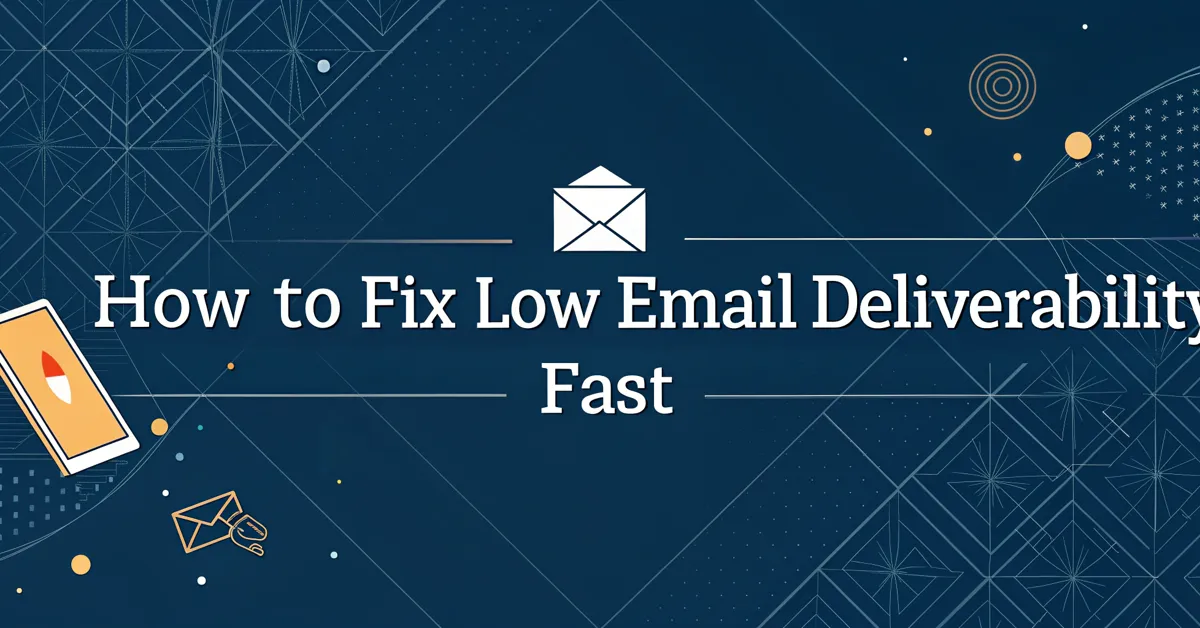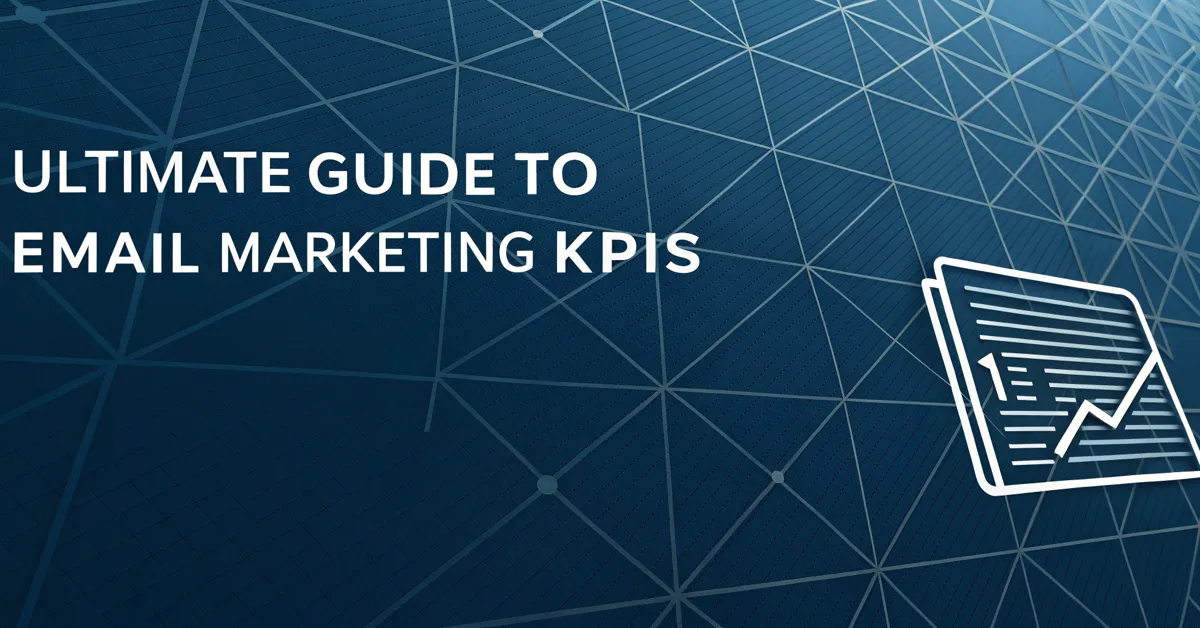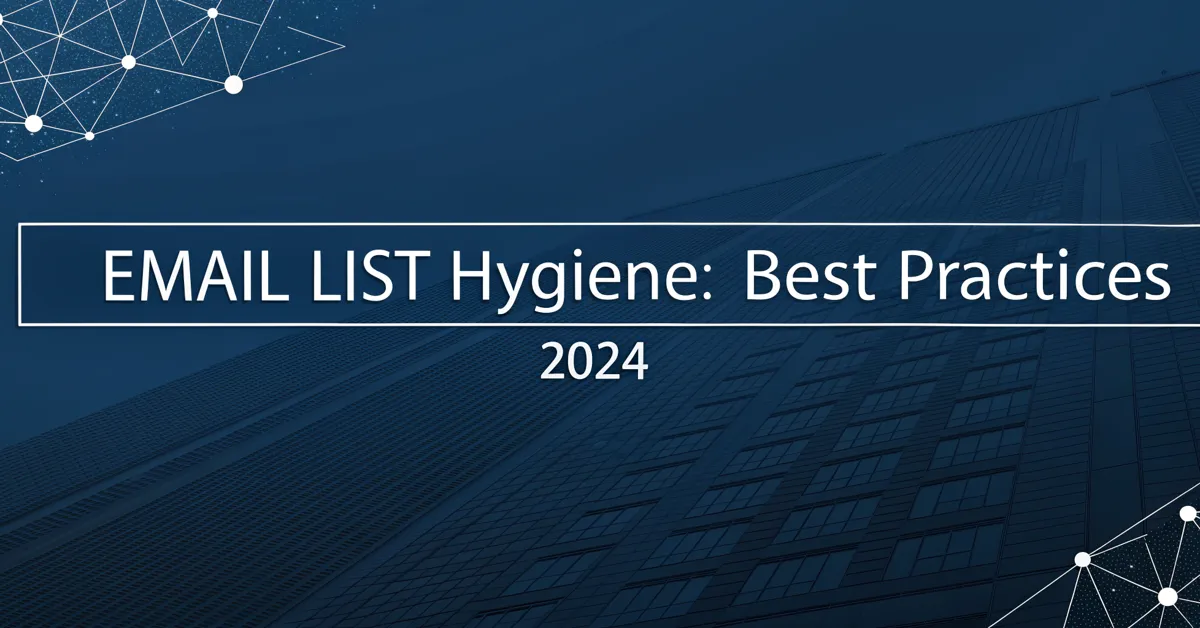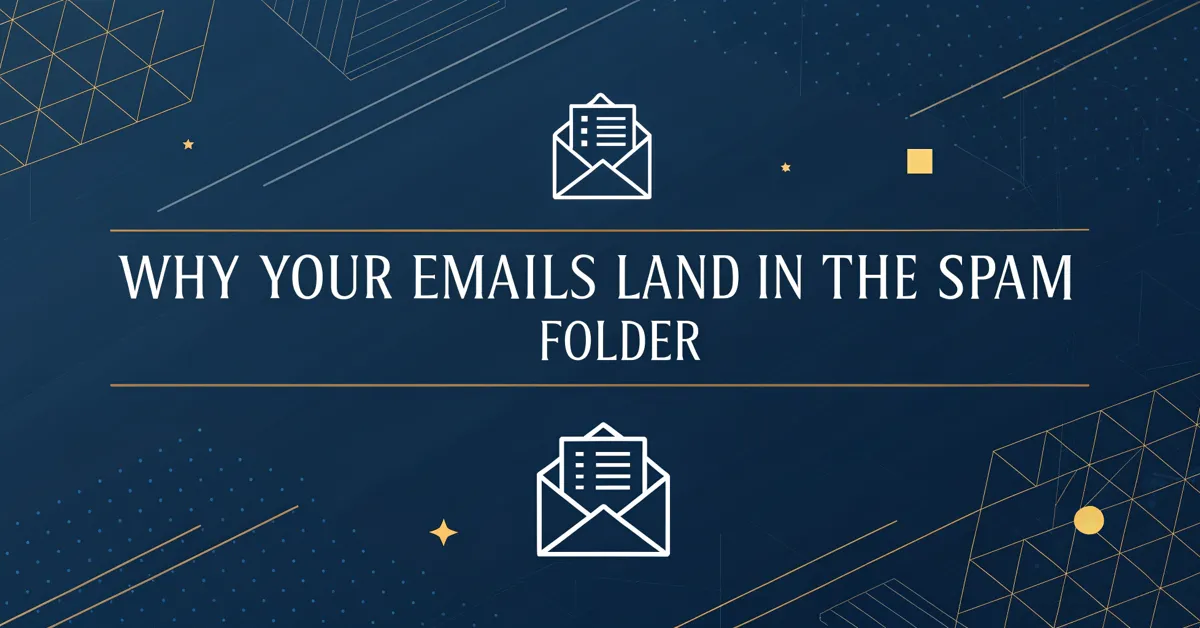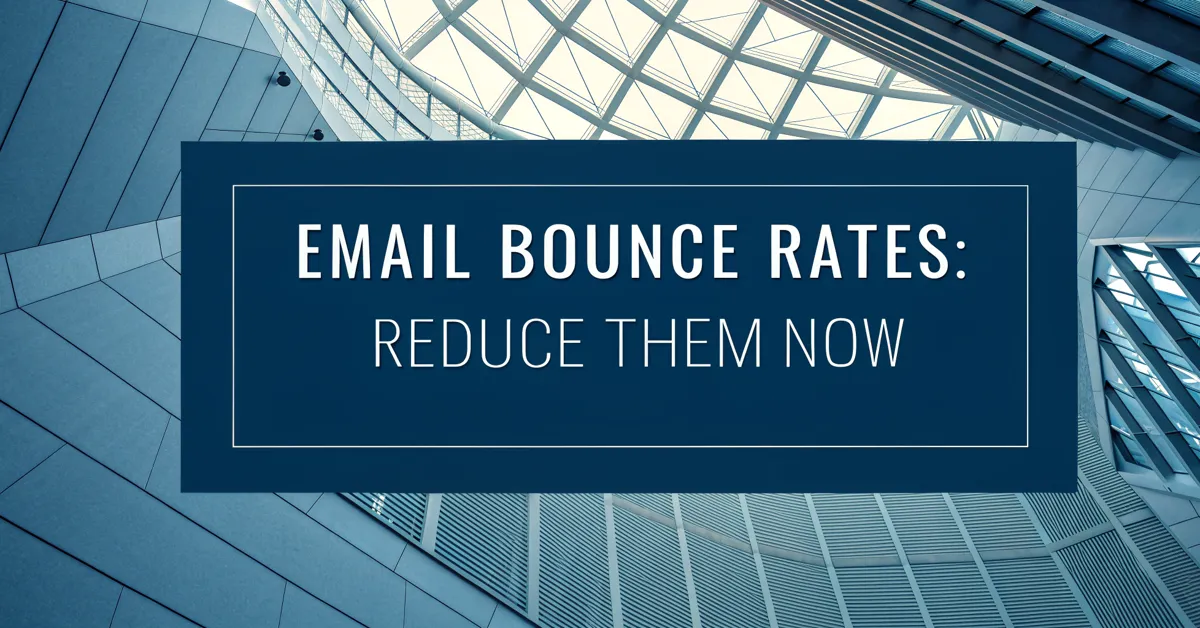Is your email marketing hitting a wall? Are your carefully crafted messages vanishing into spam folders, unseen and unread? It’s a frustrating place to be, but you’re not alone. Many marketers face this very issue. Low email deliverability can tank your efforts, but here’s the good news: it can be fixed. This article will show you how to quickly improve your email deliverability.
What Causes Low Email Deliverability?
Before we dive into solutions, let’s look at what could be causing your emails to land in the spam box. There are a number of factors at play. It’s not as simple as a single switch or lever. Instead, think of it as a bunch of little things that add up. Ignoring them can send a huge portion of your emails straight to the junk folder, but taking action on them can greatly improve your results.
Reputation Issues
Your sender reputation is like your credit score, but for email. Email providers like Gmail, Yahoo, and Outlook keep tabs on how you send emails. If they think you’re spamming folks, they will treat your messages as such, and place your emails in the spam folder. This reputation is built over time, and it’s based on how people engage with your messages. A bad reputation can be hard to shake, but it’s not an impossible challenge. It’s always best to build a good sender score from the start, rather than having to repair a bad one. There are ways to check your reputation that we’ll touch upon later.
Content Problems
The stuff inside your email matters. Spam filters have gotten very smart over the years. They scan the text and images inside your email, and make judgments based on that. The filters are looking for tell-tale signs of a spam email. This can include using too many trigger words, all caps, or weird formatting. These items are known spam trigger words, and should not be added. A common trigger word is “Free”. While the word free can be used in a normal sentence, you should avoid using it multiple times in your message, or in places that the algorithm might pick up on as a red flag. It’s also a good idea to ensure your message isn’t just a giant block of text. Use headers, short paragraphs, and images to break it up.
Authentication Issues
Email authentication is a way for you to say, “Yes, this email really is from me.” Think of it as an ID card for your emails. When your emails aren’t properly authenticated, email providers get suspicious. It’s like showing up to an airport without a passport. They have no real way of knowing who you really are. There are three core authentication protocols you need to know: SPF, DKIM, and DMARC. These seem technical, and they are, but they’re vital to improving your deliverability. We’ll show you what they are and how to set them up later in this guide.
List Quality Issues
How you build your email list matters. If you buy lists or add people without their clear permission, you’re setting yourself up for low deliverability. Those people will often report your emails as spam. When this happens, email providers pay attention, and it hurts your sender reputation. It’s better to grow an organic list of people who want to hear from you. They will engage with your messages and be more likely to interact with your emails, resulting in good reputation.
Technical Issues
Sometimes, deliverability issues aren’t about content or reputation. They can also be due to technical issues. Things like sending emails from a shared IP address, or not following the proper email sending protocols. These types of issues can be hard to spot, but when fixed, they can have a big impact on your overall results. We’ll look at some common technical errors, and how to resolve them.
How to Fix Email Deliverability Issues Fast
Now that you know the common reasons why emails end up in the spam folder, it’s time to get hands-on. Here’s a step-by-step guide on how to fix email deliverability fast:
Check Your Sender Reputation
The very first thing you need to do is see where you stand. There are free tools that will show your sender reputation. This will provide a very clear picture of your position. It will show you whether your reputation is low, medium or high. Here are the steps on how to use this tool.
- Go to a reputable sender score tool online, such as Sender Score.
- Enter your domain.
- Review your reputation.
If your score is low, don’t panic. It’s fixable. The next steps in this guide will help improve your reputation.
Authenticate Your Emails
Email authentication is not optional. It’s a core component of email deliverability. Here are the three main protocols you need to implement:
-
SPF (Sender Policy Framework): SPF is a way to tell email providers which servers are allowed to send emails on your behalf. You need to create an SPF record that lists the servers you will use to send messages. If an email comes from a server that’s not on your list, the email provider will mark it as suspicious. This action is not the best for your deliverability. You will need to access your domain’s DNS settings to configure this.
-
DKIM (DomainKeys Identified Mail): DKIM adds a digital signature to your emails. This signature tells email providers that the message is really from you and hasn’t been changed along the way. Just like with SPF, you will need to add a DKIM record in your domain’s DNS settings.
- DMARC (Domain-based Message Authentication, Reporting & Conformance): DMARC uses SPF and DKIM to tell email providers what to do with emails that fail authentication. You can use it to report issues with your email delivery. This also involves a record in your DNS settings.
Configuring these can seem complex, but your email marketing service should have a guide on how to set them up. This is a necessary step to ensure deliverability. Here’s why: If an email is not properly authenticated, it will be rejected, or placed in the junk folder. It will also make your emails look less trustworthy.
Clean Up Your Email List
You need to get rid of people who don’t engage with your emails. They are dragging down your reputation. Here are steps to take:
- Remove inactive subscribers: If someone hasn’t opened an email from you in a few months, it’s best to remove them. They are not benefiting from your emails, and may report you as spam.
- Check for hard bounces: Hard bounces mean an email address doesn’t exist anymore. Remove these from your list right away.
- Set up a double opt-in process: This means that when someone signs up for your list, they will get a confirmation email. They need to click a link in that email to confirm their subscription. This ensures everyone on your list wants to be there. This ensures you have a high level of engagement in your emails, which will result in good reputation.
- Avoid buying email lists: Purchased lists are a recipe for disaster. Those people never gave you permission to email them. This is not a good look for any brand, and it can result in your emails being sent to the junk folder. They will be more likely to report you as spam.
- Segment your list: Group your subscribers based on their actions. This way, you can send relevant emails and improve engagement. If you run multiple different services, it’s a good idea to segment your audience based on what they bought from you. This way you can be sure to send relevant emails that the subscriber may want to receive.
- Run a re-engagement campaign: Send a specific campaign to people who haven’t engaged with your emails in a while. Give them the chance to stay on your list. If they do not take any action, remove them.
A clean list is vital for good deliverability. It shows email providers you’re only sending emails to people who want to get them. A good list is a well engaged list. An engaged list shows positive signals to email providers, which results in higher deliverability rates.
Improve Your Email Content
Your content can make or break your email deliverability. Here’s how to make sure your emails aren’t triggering spam filters.
-
Avoid spam trigger words: Steer clear of words and phrases that spam filters look for. Examples are: “Free,” “Guarantee,” “Discount,” and “Act Now.” Use more natural language. If you must use words like free, use them with caution, and do not overdo it.
-
Don’t write in all caps: Using ALL CAPS is often seen as shouting. It’s a signal of a spam email. Do not overdo the use of caps. Use sentence case for the most part, and only use all caps for certain words for emphasis.
-
Use a proper subject line: The subject line is the first thing someone sees. Make it clear, relevant, and not misleading. Avoid being too salesy or sensational. The subject line needs to convey what your message is about. It’s a good idea to create variations of your subject line so you can test what your subscribers respond to best.
-
Use clean formatting: Don’t make your email just a huge block of text. Use headers, short paragraphs, and bullet points to make it easy to read. Make sure it is well structured, this way your readers can skim through and get the information they need.
-
Add an unsubscribe link: It’s important to have a clear way for people to leave your list. This builds trust. It also avoids people reporting your email as spam to get off your list.
-
Optimize your email for mobile: A lot of people check their emails on their phones. Make sure your emails look good on smaller screens.
- Test your emails: Before sending a big campaign, test your emails with a service. See if it lands in spam folders. This way, you can correct any mistakes before a big campaign.
Quality content will help you engage readers. They will be more likely to respond to your messages. This will send positive signals to email providers, which will result in improved deliverability.
Change Your Sending Habits
The way you send emails can affect deliverability. Here are some key things to consider:
- Warm up your IP address: If you’re sending from a new IP address, do not send a large number of emails at once. Start slow, and build up the number of messages over time. This helps build a good reputation with email providers. Sending a big batch of emails from a new IP address is a huge red flag, and it will result in your emails being sent to the junk folder.
- Send emails at regular intervals: Don’t send all your emails at once, then stop sending for a while. Consistent sending tells providers you’re a reliable sender. This will improve your score. Sending too many emails in a short period of time can be flagged as suspicious.
- Be careful with attachments: Attachments can trigger spam filters. If you need to share a document, use a link to an online document instead.
- Use a dedicated IP address: If you can, send your emails from a dedicated IP address. This gives you full control over your sending reputation. Sending emails from a shared IP address can lead to deliverability problems. This is because you might be sharing the IP address with other senders. If their messages get flagged as spam, it can affect your email deliverability as well.
- Limit your sending frequency: Do not send too many emails in a short period. This can make you seem like a spammer. You should aim for a consistent, regular sending pace.
These habits can greatly impact your reputation and your overall deliverability. Sending emails responsibly and with a clear schedule are important factors. When you send at regular intervals and do not have huge bursts of emails sent, your reputation score will increase, resulting in better deliverability rates.
Monitor Your Results
It’s not enough to just implement these changes. You need to track your results to see what’s working and what isn’t. Here’s what you should monitor:
- Open rates: How many people are opening your emails. A low open rate can mean your emails are going to the spam folder. The open rate is the first metric you should analyze after sending a campaign.
- Click-through rates: How many people are clicking on links in your emails. A low click-through rate could mean you are sending to people who are not engaged in your content. A low click-through rate could also mean your message isn’t attractive, and this can hurt your sender reputation.
- Bounce rates: How many emails are not being delivered. High bounce rates hurt your sender reputation. Low bounce rates indicate you are sending to valid email addresses. Hard bounces are the worse type of bounce, and you should aim to have as little as possible of those. This happens when a specific email address does not exist. Soft bounces happen when the email exists, but is not currently accessible for a number of reasons (full inbox, server down).
- Spam complaints: How many people are marking your email as spam. High rates of spam reports are not good. A high spam report can lead to many consequences, like being blacklisted, and having a low deliverability score.
- Unsubscribe rates: How many people are unsubscribing from your list. While unsubscribes are a normal part of email marketing, a high number of unsubscribes could mean there is an issue with your email content, or with your sending frequency.
Use these metrics to make changes to your campaign. Adjust the frequency, the content, and the audience. If something isn’t working, change it! This constant monitoring of results can help you identify what is working and what is not.
Use a Reputable Email Marketing Service
The email marketing platform you choose can make a big impact on your deliverability. Use a platform that is a known leader in the industry. Some of the best-known options include platforms like Mailchimp, Constant Contact, Sendinblue, or HubSpot. Make sure the email marketing tool has the necessary functionality you will need.
- Reputation Management: A good email marketing tool will help you track your sender reputation. It should also have the necessary steps you should follow to improve your score.
- Email Authentication: Your email marketing tool should support SPF, DKIM and DMARC. This is necessary for email deliverability. The tool will usually guide you through the necessary steps to make this happen.
- List Management: The tool should give you the necessary functionality to manage your email list effectively. Options to clean up lists, segment them, and have double opt-in processes, should all be available.
- Content Testing: The platform should give you a way to test your email content and see how well it will land with spam filters. This feature is very helpful when testing new email messages.
- Detailed Analytics: The tool should provide you with detailed analytics on your email campaigns. This is essential for the monitoring process, and for identifying the areas that need improvement.
- Customer Support: Your tool should have a good customer support team to help you solve any technical problems that you encounter.
Make sure to choose a reputable tool that will help you in all these aspects. Your deliverability score will greatly benefit from a good email marketing tool.
Seek Expert Help
If you’ve tried everything above and you’re still having trouble, it might be time to get help from someone who specializes in email deliverability. Email marketing experts will be able to dive into your unique situation and help solve your issues. This may cost some money, but it’s a good investment.
- Email Marketing Consultants: These professionals can review your campaigns, your sending methods, and your deliverability strategy. They can help you identify blind spots and areas for improvement.
- Email Marketing Agencies: A specialized agency can manage your email marketing for you. This can free you up to focus on other aspects of your business. Agencies have tools and resources that most businesses lack.
- Online Courses: If you don’t want to hire an expert, there are a number of online courses that can help improve your deliverability. These courses will provide in-depth training on the subject. This will help you gain the necessary knowledge to fix your problems and to prevent them from happening again.
Seeking expert help might be the most effective route to take. This way you are ensuring someone who specializes in the field can look at all the aspects of your campaign and help identify areas that need improvement.
What to Avoid When Improving Email Deliverability
When working on improving your deliverability, it’s just as important to know what not to do, as it is to know what to do. Here are some actions to avoid that can hurt your email deliverability.
- Do not use a free email address: Avoid using a free email address such as @gmail.com or @yahoo.com to send emails from. This looks very unprofessional and untrustworthy. Instead, always use an email address with your brand domain, like @yourdomain.com.
- Do not overuse images: While images can make your emails visually appealing, you need to use them with caution. Emails that are too image heavy, can be tagged as spam. Also, slow load speeds can cause your email to not display correctly.
- Do not use URL shorteners: URL shorteners can look suspicious. These shorteners can be hiding malicious links. They will often be blocked by email providers. Instead, always use full, clear URLs.
- Do not send too many emails: Sending too many emails will make your subscribers disengage. This can result in spam reports, and poor deliverability. It’s best to find a good sending pace, and not overdo it.
- Do not skip email testing: Always test your emails before you send them. This way, you can avoid making mistakes. Testing your emails will give you a heads up on issues with the subject line, the content, or the deliverability of the email.
- Do not ignore unsubscribe requests: If someone requests to unsubscribe, you must remove them right away. Ignoring them will cause them to report you as spam, and this will have a negative impact on your deliverability.
- Do not use misleading subject lines: If your email subject line is misleading, it may entice users to open the email, but they will likely disengage when they find the email isn’t what they expected. They will be more likely to report it as spam.
- Do not copy content from other sources: Your content needs to be original. Do not just take content from other sources, this is not a good look for your brand, and it can hurt your deliverability.
- Do not use generic language: Use specific language in your messages. Your messages should have a clear intention, and not just be broad sentences that don’t mean much.
- Do not use a non-existent “From Name”: If you are a business, do not send emails as “John Doe” or “Marketer”. Use a real brand name, or a name and brand name in your “From Name”. This is very important, as it establishes that your email is from an actual person, or brand, and not from a bot.
By avoiding these mistakes, you will be on the path to a much better deliverability score.
Is Fixing Email Deliverability a Quick Process?
Now, you might be wondering, is this a quick fix? Can you change things overnight, and have your emails landing in inboxes by tomorrow? The truth is, improving your email deliverability is usually a process. While you can implement some changes quickly, the full effect can take time. Here’s a more clear picture:
- Immediate impact: Authenticating your emails, cleaning your list, and adjusting your content, can produce a noticeable improvement quickly.
- Gradual improvement: Building a good sender reputation, takes time. This is a step by step process. Sending emails on a regular schedule and consistently monitoring your results takes time and attention.
- Continuous work: Email deliverability is not a set-it-and-forget-it task. It’s an ongoing process that will require continuous monitoring and adjustments. Email is constantly evolving, and it’s important to keep up with the latest best practices and guidelines.
- Factors beyond your control: Sometimes, even if you do everything right, external factors might affect deliverability. Email providers can change their algorithms, or your subscribers may change their habits. That’s why it’s so important to monitor your metrics regularly, and be ready to change things as needed.
So, while you can see improvements quickly, it’s important to understand this is an ongoing effort. Treat email deliverability as a key part of your marketing strategy, and dedicate the resources and time that it needs.
Long-Term Strategies for Email Deliverability
You might fix your deliverability issues now, but what about the future? Here are some long-term strategies that will ensure you keep your deliverability high:
-
Content Value: Focus on providing valuable, useful and relevant content to your subscribers. They need to feel that what you’re sharing with them is useful. High-quality content is a key element to keep engagement high.
-
Build relationships: Build relationships with your subscribers. Make them feel like they are more than just another email on your list. Ask for their feedback, and make changes according to their needs. When they feel heard, they will be more likely to engage with your content, and with your brand.
-
Segment your list: You should not send the same emails to all your subscribers. Use list segmentation to send relevant content based on their needs, interests, and engagement history. They want messages that resonate with them, and not generic bulk emails.
-
Be consistent: Stick to a consistent sending schedule. Send emails at the same day, and at the same hour every week. Your subscribers will appreciate the consistency. Email providers also like consistent email campaigns, it’s a sign of a well-run marketing effort.
-
Monitor and adjust: Keep a close eye on your email metrics and keep making adjustments to improve your performance. Analyze the results of every campaign, identify what is working and what is not, and make changes as you go.
-
Get educated: Always keep up with the most current email marketing guidelines and best practices. Email marketing is a changing landscape. New trends come up often, and you must be ready to adapt.
-
Comply with all regulations: Always comply with all the email marketing regulations. Make sure to follow every guideline and not make assumptions. Regulations can be different based on the territory. This is very important to ensure you are within the law.
These long-term strategies are vital to maintaining high deliverability rates. You need to have the proper mindset. Email marketing is not a sprint, but a marathon. Be ready to go the distance and focus on the long-term game.
Is Fixing Email Deliverability Worth It?
After all this information you might be asking yourself, is fixing my deliverability worth it? It’s a fair question. You’ve now read how much work it takes, and how many steps you need to take. The short answer is a resounding YES. Here’s why:
- Better reach: If your emails land in the inbox, more people will see your messages. This will allow you to reach more of your potential audience.
- More engagement: More people opening your emails means that more people are going to engage with your content. This results in higher click-through rates, and more engagement with your brand.
- Higher conversion: Better engagement leads to more people taking action, buying, or following up with your calls to action. When your emails land in the inbox, they have a much higher chance of converting into customers.
- Improved reputation: When you have high deliverability rates, this results in a good sender reputation. This positive feedback loop allows you to keep reaching more people, and converting them into customers.
- Higher ROI: All these items lead to a higher return on investment. The better your deliverability, the more results you will have.
Think of it this way: If you are writing excellent content, but your emails are not getting to the intended audience, it’s as if you aren’t even trying. This is a terrible position to be in. Improving your email deliverability is the very first step to getting any type of real results from your email campaigns.
Making Sure Your Emails Reach the Inbox
Fixing your email deliverability isn’t a magic trick, it’s about having the right knowledge and applying the correct steps. It will require consistent effort, and the will to always improve. You now have the tools to improve your deliverability. It’s time to put them to work. Do not postpone your deliverability plan for another day. The sooner you work to improve your score, the sooner you will see the positive results you want from your email campaigns.
